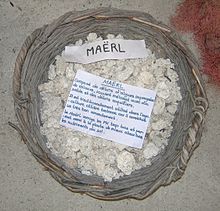- Maerl
-
Maerl in Lanildut.

Maerl (or marl) is a collective name for Coralline red algae with a certain growth habit.[1] It accumulates as unattached particles and forms extensive beds in suitable sublittoral sites.[2]
Contents
Description
In the British Isles maerl is composed of three species of coralline algae growing loose in beds of fragmented nodules in the sub-littoral. The species generally involved are: Lithothamnion corallioides,[1]Lithothamnion glaciale and Phymatolithon calcareum.[3][2]
Maerl is dredged from the sea floor and crushed to form a powder. It is still harvested around the coasts of Brittany in France and Bantry Bay, Ireland, and is a popular fertilizer for organic gardening. It was also dredged off Falmouth, Cornwall, but this ceased in 2004. Scientists investigated Falmouth maerl and found that L. corallioides predominated down to 6 m and P. calcareum from 6-10 m (Blunden et al., 1981).[4][5]
Chemical analysis of maerl showed that it contained 32.1% CaCO3 and 3.1% MgCO3 (dry weight).
Ecology
Maerl has no tolerance for desiccation.[6]
History
An early reference to maerl was made by John Ray in 1690 who reported it from Falmouth. Maerl is still harvested at Falmouth, as well as elsewhere.[3] In Ireland, maerl is extracted from subfossil beds in Bantry Bay by Celtic Sea Minerals [3]. The maerl-forming species Lithothamion corallioides and Phymatolithon calcareum are listed in Annex V of the EC Habitats Directive [4].
Uses
Used as a soil conditioner, it is dredged from the sea floor and crushed to a powder.[7] The slow growth of individual nodules and their accumulation in beds over a millennial timescale means that there is no possibility of maerl keeping up with dredging for this purpose. Maerl should be considered as a non-renewable resource, and readily available alternative products (e.g., garden lime) make modern day exploitation questionable.
References
- ^ Steneck, R. S. (1986). "The Ecology of Coralline Algal Crusts: Convergent Patterns and Adaptative Strategies". Annual Review of Ecology and Systematics 17: 273–303. doi:10.1146/annurev.es.17.110186.001421. JSTOR 2096997.
- ^ Vize, S.; Blake, C.; Hinojosa, G. and Maggs, C.A. 2003. The distribution and composition of maerl beds in Northern Ireland. PMNHS Newsletter No.13 p.26
- ^ a b Irvine, L.M and Chamberlain, Y.M. 1994. Seaweeds of the British Isles. Volume 1, Part 2B. The Natural History Museum, London. ISBN 0-11-3100167
- ^ Blunden, G.; Farnham, W. F.; Jephson, N.; Barwell, C. J.; Fenn, R. H. and Plunkett, B. A. (1981) The composition of maerl beds of economic interest in northern Brittany, Cornwall, and Ireland. Proceedings of the International Seaweed Symposium. 10: 651 - 656
- ^ Blunden, G; Campbell, S A; Smith, J R; Guiry, M D; Hession, C C and Griffin, R L (1997) Chemical and physical characterization of calcified red algal deposits known as maërl. J. Applied. Phycol. 9: 11 - 17
- ^ Wilson, S.; Blake, C.; Berges, J. A.; Maggs, C. A. (November 2004). "Environmental tolerances of free-living coralline algae (maerl): implications for European marine conservation". Biological Conservation 120: 279–289. doi:10.1016/j.biocon.2004.03.001.
- ^ Thomas, D. 2002. Seaweeds. Life Series. The Natural History Museum, London ISBN 0-565-09175 1
Categories:- Red algae
- Environment of Cornwall
Wikimedia Foundation. 2010.

